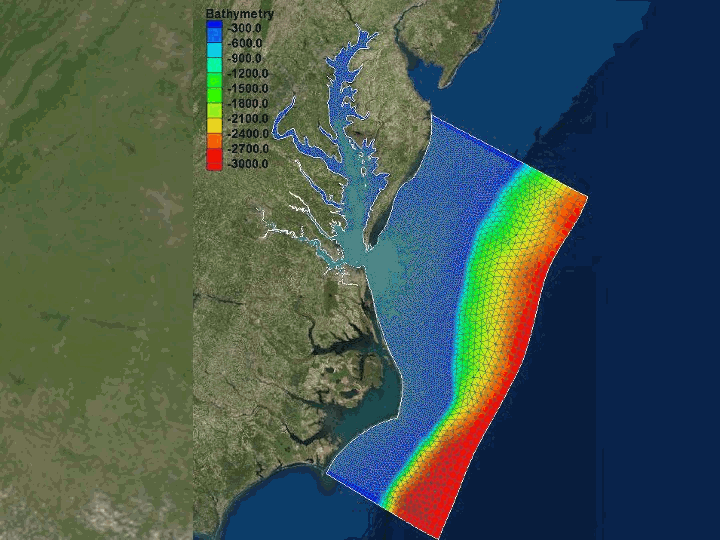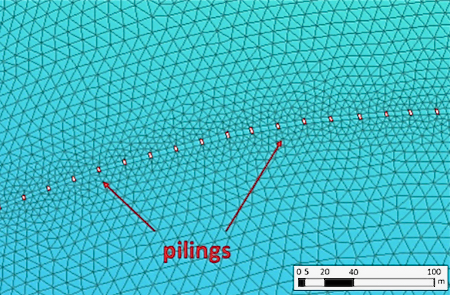EPA selects VIMS model as bellwether for Bay health
SCHISM recognized as next-generation tool to monitor, manage restoration efforts
The U.S. Environmental Protection Agency has chosen a computer model developed by researchers at William & Mary’s Virginia Institute of Marine Science as its next-generation tool for managing Chesapeake Bay restoration in an era of rapid climate change.
The selected model, known as SCHISM for Semi-implicit Cross-scale Hydroscience Integrated System Model, was developed by Dr. Joseph Zhang of VIMS’ Center for Coastal Resources Management (CCRM).
Selection of the SCHISM model is the first step in a 6-year, $1.65M cooperative agreement between VIMS and the EPA’s Chesapeake Bay Office, in collaboration with the many other federal, state, and tribal partners that make up the Chesapeake Bay Program (CBP). Joining Zhang on the modeling team are Drs. Harry Wang, Jian Shen, Marjorie Friedrichs, Pierre St-Laurent, Fei Ye, Zhengui Wang, Qubin Qin, and Nicole Cai of VIMS, along with Dr. Jeremy Testa of the University of Maryland Center for Environmental Science. Slated to begin operating in 2025, SCHISM will replace a model that has been used to monitor and guide the Bay Program’s restoration efforts since the early 1990s.
“This award represents a firm commitment from CBP to adopt our next-generation technology, fulfilling a dream conceived more than 10 years ago,” says Zhang. That’s when he and other members of the SCHISM team began working with multiple collaborators to bring their modeling technology into the mainstream of Chesapeake Bay science. Zhang cites a 2018 workshop organized by the Bay Program’s Scientific and Technical Advisory Committee as a major step toward reaching that goal.
 Lewis Linker, modeling coordinator for EPA’s Chesapeake Bay Program Office, says “SCHISM is state-of-the-science and will become the Main Bay Model in a new suite of integrated CBP models, replacing the award-winning Bay Model used successfully by the CBP for more than three decades.” Linker notes that SCHISM will integrate with new and updated models of the watershed, airshed, and future land use, all directed to assess challenges to the Chesapeake watershed and Bay beyond 2025, in particular the 2035 climate risk to Bay restoration goals.
Lewis Linker, modeling coordinator for EPA’s Chesapeake Bay Program Office, says “SCHISM is state-of-the-science and will become the Main Bay Model in a new suite of integrated CBP models, replacing the award-winning Bay Model used successfully by the CBP for more than three decades.” Linker notes that SCHISM will integrate with new and updated models of the watershed, airshed, and future land use, all directed to assess challenges to the Chesapeake watershed and Bay beyond 2025, in particular the 2035 climate risk to Bay restoration goals.
Refining SCHISM for operational use in the Bay will proceed in coordination with a separate memorandum of understanding between VIMS and NOAA’s Office of Coast Survey, which is teaming with NOAA's Office of Water Prediction to begin incorporating SCHISM into their models.
SCHISM’s capabilities will allow it to incorporate climate-change impacts and help assess all Chesapeake Bay water-quality standards, two key requirements of the Bay Program’s search for a new modeling platform. That search took place as the Chesapeake Bay Watershed Agreement struggles to meet its 2025 restoration deadlines and program partners shift their focus to restoring and maintaining Bay health despite its rapid warming.
Dr. Kirk Havens, CCRM director, says “SCHISM's next-generation capability offers an essential planning tool as climate change continues to impact communities and economies not just in the Bay but around the world.”
Dr. Derek Aday, VIMS Dean and Director, adds that “SCHISM highlights our vision to address global challenges and forge dynamic partnerships to solve real-world problems, and positions VIMS, William & Mary, and Virginia as global leaders in hydroscience.”
“The SCHISM team is keeping us at the cutting edge of practical, science-based solutions to some of the world's biggest environmental challenges,” says W&M President Katherine Rowe. “Its impact will be felt right here in the Chesapeake and well beyond. This is exactly what we mean in Vision 2026 by expanding William & Mary's reach with research of impact.”
The need for a new Bay model
The new EPA-VIMS agreement recognizes that the Bay Program’s current regulatory model has reached its spatial and computational limits after more than two decades of continued refinement, particularly given that climate change and sea-level rise now necessitate even stricter pollution limits to meet previously defined restoration targets.
 Climate change impacts all the Bay Program’s water-quality criteria. Warming promotes nutrient-fueled algal blooms that suck oxygen from the water when the algae die, sink, and decay; and can stress or kill eelgrass, limiting its contribution of photosynthetic oxygen to surrounding waters and decreasing its ability to keep the water clear by stabilizing bayfloor sediments against waves and currents. Warmer water also holds less oxygen, stressing or killing marine animals such as striped bass. Rising seas and more intense precipitation also contribute to water-quality woes in the Bay, as flooding and erosion can carry both excess nutrients and sediments into Bay waters.
Climate change impacts all the Bay Program’s water-quality criteria. Warming promotes nutrient-fueled algal blooms that suck oxygen from the water when the algae die, sink, and decay; and can stress or kill eelgrass, limiting its contribution of photosynthetic oxygen to surrounding waters and decreasing its ability to keep the water clear by stabilizing bayfloor sediments against waves and currents. Warmer water also holds less oxygen, stressing or killing marine animals such as striped bass. Rising seas and more intense precipitation also contribute to water-quality woes in the Bay, as flooding and erosion can carry both excess nutrients and sediments into Bay waters.
All told, a 2020 assessment by Bay Program staff estimates that by 2035, warming will have doubled the 2025 “load effect.”
SCHISM–with its finer, 1-meter resolution and improved capacity to interface with other components of the Bay modeling system—will help regulators address these more stringent limits by guiding decision-making at the scale of local watersheds and jurisdictions, where most opportunities for further nutrient reductions are to be found.
“Existing and impending changes in precipitation patterns, sea level, and groundwater require a model that can integrate across water and land in order to better prepare coastal and island systems,” says Havens.
"The previous Bay model stops at the current shoreline,” adds Zhang, “but that is projected to move landward as sea level rises in the coming decades. SCHISM’s more detailed shoreline will allow much better coupling with the next-gen watershed and airshed models CBP is developing, thus leading to more detailed and localized predictions for climate-change impact.”
What sets SCHISM apart
A “hydrodynamic” model, SCHISM represents the state-of-the-art in simulating tidal water motion and other properties in a shallow coastal estuary such as the Chesapeake, with the capacity to interface with the watershed, airshed, and ocean models that complete the Bay Program’s management modeling system.
Havens says the strengths of the SCHISM model include its capacity to “seamlessly integrate across scales, from the open ocean to bays, rivers, and streams; and to be coupled to land-based models for groundwater and precipitation.”
 Zhang explains that several technical features set SCHISM apart. One is the use of an “unstructured grid” that enables flexibility and efficiency by deploying high-resolution cells where resource managers might require a detailed simulation, while using lower resolution to save computational cost in regions of little interest. The unstructured grid can also closely mimic the Bay’s intricately convoluted shoreline, allowing for highly accurate simulations of land-sea interactions.
Zhang explains that several technical features set SCHISM apart. One is the use of an “unstructured grid” that enables flexibility and efficiency by deploying high-resolution cells where resource managers might require a detailed simulation, while using lower resolution to save computational cost in regions of little interest. The unstructured grid can also closely mimic the Bay’s intricately convoluted shoreline, allowing for highly accurate simulations of land-sea interactions.
SCHISM also uses an “open boundary” to allow for more seamless integration with the other models that complete the Chesapeake Bay Program’s modeling suite. Its open boundary will also allow for integration with an ocean model, a critical prerequisite for accurate simulations of climate-change impacts in the Bay. A 2020 VIMS study shows ocean warming accounts for more than half of summer warming in the bottom waters near the Bay mouth.
Another key feature of SCHISM is its refined time-stepping algorithm, which maximizes computational efficiency even under a resolution as fine as 1 meter. “This is one of the important considerations EPA and NOAA have for operational models,” says Zhang.
Overall, says Zhang, “SCHISM offers a comprehensive modeling system that includes physics, chemistry, and biology while coupling with other components like the atmosphere in a parallel framework. All of these characteristics make the model bona fide ‘next-gen.’”
Havens describes growing interest in SCHISM from industry, the Department of Defense, and state and foreign entities, such as the European Union. “The synergy created by all our modeling and monitoring activities will be able to sustain a long-term program and should make VIMS a world-class computing center,” he says.
High-Performance Computing
Higher resolution models can more accurately simulate the real world, but that extra fidelity requires greater computational power to solve the increased number of mathematical equations that dictate the transfer of energy, motion, and materials between and among its many cells.
 SCHISM’s computational needs are met by W&M’s High Performance Computing cluster. “HPC resources are indispensable for making the turn-around time of simulations acceptable,” says Zhang. “This is especially important for the very large and high-resolution meshes we’re developing for EPA and NOAA.” Zhang says his team “sincerely acknowledges the generous support from W&M and VIMS in expanding the HPC capacity over the next few years to accommodate these very demanding projects.”
SCHISM’s computational needs are met by W&M’s High Performance Computing cluster. “HPC resources are indispensable for making the turn-around time of simulations acceptable,” says Zhang. “This is especially important for the very large and high-resolution meshes we’re developing for EPA and NOAA.” Zhang says his team “sincerely acknowledges the generous support from W&M and VIMS in expanding the HPC capacity over the next few years to accommodate these very demanding projects.”
W&M’s HPC cluster contains nearly 10,000 processor cores. Together with an interoperable cluster at VIMS, they have a theoretical peak performance of 360 teraflops–360 trillion floating point operations per second. That equals the computational might of more than 10,000 laptops.

